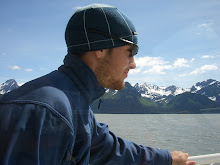 (Image "Dope on a Rope" from www.tetonat.com )
(Image "Dope on a Rope" from www.tetonat.com )That's a picture of a "short haul" technique used to insert rescuers and evacuate patients from highly technical terrain. Its certainly one of the perks of SAR because its a ton of fun and certainly something different from the normal EMS routine (which is "treating" patients who don't really need your help).
Advantages include decreasing the hover time (which is the most dangerous time period of any helicopter operation) and staying away from the more complicated winch in/winch out mechanics.
Disadvantages include no visual communication with the pilot (radio only) and it requires a tremendous amount of skill on the pilot's part to avoid flying the rescuer and patient into trees, buildings, rock walls, etc. Sadly, such an event happened recently with one of the most accomplished mountain rescue teams in the country. The patient was killed and the rescuer critically injured.
Usually, our team is inserted via helicopter on a ridge and then we descend to the patient. In this manor, the ship is usually on the ground (or has one skid down) and we exit out the doors onto non technical terrain. Per FAA regulations, short hauling, winching, and rappelling out of civilian helicopters is strictly prohibited except by a very select few trained individuals who work for the helicopter companies. For example, there is only one civilian air ambulance company who is allowed to winch patients and their medics in and out.
That's great... but I really don't give a shit. If inserting via technical means (mentioned above) is the safest way I can get to my patient I'm going to do it and ask for forgiveness if necessary. I've always followed the motto that "The fastest way to the hospital is the best". We're lucky that we have a helicopter crew that is willing to support these transgressions.
Case in point; a few days ago we had a MCI on a large rock face. Multiple patients took extended (500-1000 ft) falls or slides. We had a few fatalities and a lot of patients circling the drain- including pediatric patients. We had two options- climbing in from the top or bottom or short hauling in.
Hiking in would have exposed our rescuers to an extreme avalanche danger, rock fall, and a slope that was melting out. It also would have meant the death of many patients because it would have taken us an hour to reach them.
We choose to short haul two of our rescuers in and extricate the patients as soon as possible. No worries, it has become standards operating procedure. We did, and not one patient died who wasn't already dead when we arrived on scene. Considering the nature of their injuries, that is a huge accomplishment and uncommon in SAR.
In typical fashion, the news crews (who could ruin a wet dream) published the footage despite us asking them not too. The FAA saw it. We're in deep shit. But, ya know what? I'd do it again, and again, and again without a thought otherwise.
Get the patient out as fast as possible and they live... all I give a damn about.

1 comment:
Good for you, although I'd be careful posting this kind of stuff, as you might be identifiable from the details of what you wrote.
WWW, who worked as an EMT for a couple of years back in the ancient days when people bleeding all over you was mostly a laundry problem.
Post a Comment